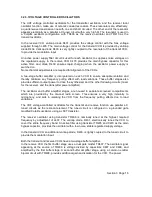
The CTCSS encode and decode function is performed in a single integrated circuit. The IC is
controlled by the microprocessor. The encoder/decoder IC also provides a high pass filter
when in receive mode to remove the demodulated tone ahead of the audio power amplifier,
and in transmit mode to reject low frequency microphone audio prior to modulating the
transmit VCO.
A reverse tone burst feature is provided in two formats. A 180 degree phase shift is available
in encode directly out of the encoder/decoder IC and a -120 degree phase
shift is provided by an additional circuit.
3.1.6 Power Supply and Reset
Three regulated supply voltages are required for operation of the transceiver circuitry. These
are +9volt, +5volt and +23volt. The +9volt and +5volt regulated supplies are derived from
integrated circuits and the +23volt supply is generated by a multivibrator circuit and a voltage
multiplier. This high voltage supply is used to provide a wider control voltage range for the
varicap diodes used in the VCOs and receiver front end filters.
A per5volt trickle supply is provided for the microprocessor. This maintains stored
information during short duration power failures and also retains the last programmed state
when the transceiver is switched off.
To ensure reliable operation of the microprocessor, an interrupt and reset circuit is provided.
This circuit detects power failure and induces the microprocessor to prepare for a reset. The
timing between interrupt and reset is carefully controlled to ensure that the microprocessor is
enabled and disabled in a predictable manner during supply failure and restoration. The reset
operation is also rate limited and will prevent the enabling of the microprocessor before the
supply voltage has sufficiently stabilised. The interrupt and reset operation is designed to
detect total loss of primary power, or supply voltage reduction below the regulator limit of the
+9 volt regulator.
3.1.7 Controls and Display
In both the 9-channel and 64-channel versions of the front panel,the visual display indicators
are provided by a liquid crystal display. A single integrated circuit is used to drive the display.
Information to be displayed is programmed and latched into the driver IC by the
microprocessor.
The momentary-acting push-button switches are connected directly to a set of dedicated
inputs on the microprocessor.
Section 3 Page 4
















































